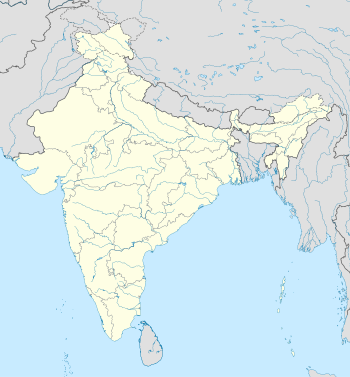Soanian
| Geographical range | Indian subcontinent[1] |
|---|---|
| Period | Lower Paleolithic |
| Dates | 500,000 – 125,000 BP[2][3] |
| Type site | Sivalik region[1] |
| Major sites | Sivalik Hills[1] |
| Preceded by | Acheulean |
| Followed by | Mousterian |
The Soanian is an archaeological culture of the Lower Paleolithic in the Sivalik Hills of the Indian subcontinent.[1][4] Contemporary to the Acheulean, it is named after the Soan Valley in Pakistan.[5] Soanian sites are found along the Sivalik region in present-day India, Nepal and Pakistan.[6] Soanian artifacts were manufactured on quartzite pebbles, cobbles, and occasionally on boulders, all derived from various fluvial sources on the Siwalik landscape. Soanian assemblages generally comprise varieties of choppers, discoids, scrapers, cores, and numerous flake types, all occurring in varying typotechnological frequencies at individual sites.[7] The closest morphological parallels to this outside of South Asia are found in the neighboring regions of Tajikistan and Iran.[8]
Findings
The term "Soan Culture" was first used by Hellmut De Terra in 1936,[9] but D. N. Wadia had identified the presence of these archaeological implements in 1928.[10] Further archaeological research was conducted by Stephen Lycett in order to determine the morphometric assessment of the Soanian techno-complex. The result of this experiment concluded that the Soanian techno-complex contains a Mode 3 Levallois technique core component.[4]
At Adiala and Khasala Kalan, about 16 km (9.9 mi) from Rawalpindi terrace on the bend of the river, hundreds of edged pebble tools were discovered. At Chauntra in Himachal Pradesh, hand axes and cleavers were found. Tools up to two million years old have been recovered. In the Soan River Gorge, many fossil bearing rocks are exposed on the surface. 14 million year old fossils of gazelle, rhinoceros, crocodile, giraffe and rodents have been found there. Some of these fossils are on display at the Pakistan Museum of Natural History in Islamabad.
See also
| The Paleolithic |
|---|
| ↑ Pliocene (before Homo) |
| ↓ Mesolithic |
References
- ^ a b c d Gwen Robbins Schug; Subhash R. Walimbe (13 April 2016). A Companion to South Asia in the Past. John Wiley & Sons. pp. 39–. ISBN 978-1-119-05547-1. Quote: “Soanian and Soanian‐like assemblages are known throughout the entire Siwalik or Sub‐ Himalayan region, from Pakistan to northeast India including Nepal...”
- ^ Petraglia & Allchin 2007, pp. 5–6.
- ^ Murray, Tim (1999). Time and Archaeology. London: Routledge. p. 84. ISBN 978-0-415-11762-3.
- ^ a b Lycett, Stephen J. (2007). "Is the Soanian techno-complex a Mode 1 or Mode 3 phenomenon? A morphometric assessment" (PDF). Journal of Archaeological Science. 34 (9): 1434–1440. doi:10.1016/j.jas.2006.11.001.
- ^ "Pakistan: The lesser-known histories of an ancient land".
- ^ Chauhan, Parth R., [1] An Overview of the Siwalik Acheulian & Reconsidering Its Chronological Relationship with the Soanian – A Theoretical Perspective.
- ^ Paterson, T.T., Drummond, H.J.H., 1962. Soan the Palaeolithic of Pakistan.Department of Archaeology, Government of Pakistan Karachi.
- ^ Davis, R.S., 1984. The Soan in Central Asia? Problems in Early Palaeolithicculture history. In: Kennedy, K.A.R., Possehl, G.L. (Eds.), Studies in the Archaeology and Palaeoanthropology of South Asia. Oxford & IBH Publishing Company, New Delhi, pp. 23-32.
- ^ Hellmut De Terra (1969). George Grant MacCurdy (ed.). Early man: as depicted by leading authorities at the International symposium, the Academy of Natural Sciences, Philadelphia, March 1937. pp. 267–. ISBN 978-0-8369-1184-8. Retrieved 16 October 2011.
- ^ Kenneth Oakley (30 April 2007) [1964]. Frameworks for Dating Fossil Man. Transaction Publishers. pp. 224–. ISBN 978-0-202-30960-6. Retrieved 16 October 2011.
Further reading
- Dani Ahmad Hasan (1964). "Prehistoric Pakistan" (PDF). Asian Perspectives. 7: 183–188.
- B. B. Lal (1964). "A Decade of Prehistoric and Protohistoric Archaeology in India, 1951–1960". Asian Perspectives. 7 (1–2): 144–159.
- Hellmut De Terra (1969). Early man: as depicted by leading authorities at the International symposium, the Academy of Natural Sciences, Philadelphia, March 1937. Ayer Publishing, Academy of Natural Sciences of Philadelphia. pp. 263–. ISBN 978-0-8369-1184-8. Retrieved 21 August 2011.
- J. Armand (1979). "The Middle Pleistocene Pebble Tool Site of Durkadi in Central India". Paléorient. 5: 105–144. doi:10.3406/paleo.1979.4242.
- J. Armand (1985). "The Emergence of the Handaxe Tradition in Asia, with Special Reference to India". In V. N. Misra, Peter S. Bellwood (ed.). Recent advances in Indo-Pacific prehistory: proceedings of the international symposium held at Poona, December 19–21, 1978. BRILL. pp. 4–. ISBN 978-90-04-07512-2. Retrieved 22 August 2011.
- V. A. Ranov; D. Dorj; Lu Zün-E (1999). Vadim Mikhaĭlovich Masson (ed.). History of civilizations of Central Asia. Motilal Banarsidass. pp. 45–. ISBN 978-81-208-1407-3. Retrieved 21 August 2011.
- Kenneth Oakley (30 April 2007). Frameworks for Dating Fossil Man. Transaction Publishers. pp. 223–. ISBN 978-0-202-30960-6. Retrieved 21 August 2011.
External links

